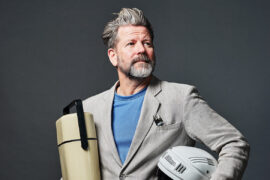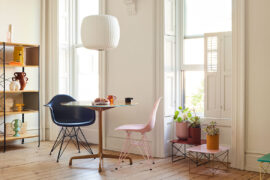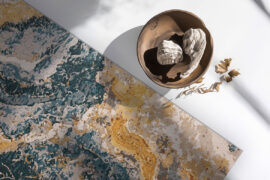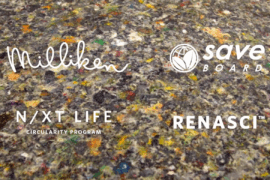A meticulous and intuitive designer, Caroline Casey has a diverse range of outstanding products to her name.
February 6th, 2018
Caroline Casey’s creativity sprang to life in a laundry room, a space her mother had cleared out and dedicated to her schoolgirl daughter’s inventive ways. Her mother also supplied materials and inspiration. Mrs Casey worked at Finlandia fabric store, in Sydney’s Woollahra, and would bring home swags of off-cuts of boldly patterned Marimekko prints.
She would take Caroline (who remembers being mesmerised at around nine years of age) to visit Florence Broadhurst’s wallpaper showroom and screen-printing works and to see the legendary interior designer, Marion Hall Best. Casey vividly recalls the “beautiful books of patterns” and her fascination with the screen-printing process.
Back in the laundry room she “was always making stuff, sewing, appliquéing,” playing with ideas and fully engaged with the hands-on pleasure of her materials.
Casey completed a BA in fashion and textile design at Sydney College of the Arts, Balmain, in 1986. The following year she opened her own fashion label, Caz Designs, designing and screen-printing her fabrics, creating the garments, and distributing them around Australia.
However, it was always the printed textiles that interested Casey more than clothing design, and within a few years, she had become disheartened by the demands of the mass-market and the nature of fashion industry. “It was all about business and not about creativity,” she says.
And having met her partner, architect Rob Brown, she was increasingly attracted to architecture and interior design, which she felt offered greater depth and more lasting value.
“I took off to New York and absolutely loved it,” says Casey, who studied interior design subjects of her choice at the Parsons School of Design. “I went there to learn technical skills, then got interested in lighting and colour.” Here she created her first pieces of furniture. She explored upholstery and resin but was particularly drawn to timber, which supplanted textiles as her medium of choice.
In 1992, Casey won the Palazzetti Design Showcase, a competition run by a major New York furniture retailer. “That’s how I got into furniture, really – purely by default. Winning that competition gave me the opportunity, it gave me a tag in New York to perform under.”
Commissions followed and, working part-time for two interior design firms, she made all the contacts she needed. Rob Brown joined her in New York for a couple of years before they returned to Australia in 1994 – a little reluctantly in Casey’s case “having had a brilliant time.”
“I left Australia in the fashion industry and came back in the furniture industry,” says Casey. She took her designs to Ute Rose at Anibou (a leading distributor of classic modern European furniture and high-quality local designs) and was offered a solo exhibition.
Rose immediately appreciated Casey’s simple and original style, finding her designs “beautiful, really clean and pared down to the essential.” Armed with a $10,000 grant from the Australia Council of the Arts, Casey’s first furniture show in Australia was held in 1995, and Anibou has continued to retail her designs ever since.
For Casey, a residency at Adelaide’s JamFactory and a further Anibou exhibition (1997) was followed by another Australia Council grant and a solo show at the Powerhouse Museum in 1998. Curated by Judith O’Callaghan, this exhibition was a significant acknowledgement of the stature of her work and contributed largely to her spreading reputation.
“I’m very clear now, but it took a long time for me to work out where the furniture sat, and where I wanted to push it,” says Casey. In 1994, when she designed her Elliptical screen, she envisaged it as an ‘IKEA piece’, flat-packed and mass-produced. She believes her fashion background led her to this approach, along with her enthusiasm for a continuous design process.
“I always wanted to go on to the next one and the next one,” she says. It was Rose – who regards Casey as “a complete perfectionist” – who steered her through this dilemma. Casey’s designs evolve slowly, says Rose, because she is constantly querying, and is not easily satisfied. “If she has even the smallest doubt she won’t let anything out.”
“I fought with her for a long time, but Ute was always right in the end,” says Casey, who is now thoroughly committed to small-run, high-quality production. “It’s taken me a long time to understand that those pieces need to be respected for the amount of time that’s gone into making them and the timber that’s used. And, they still do look good after so many years.”
Casey describes her work as having a quietness, which some call restraint. There’s nothing flippant about it says Rose, who believes that Casey’s seriousness may, in one sense, be detrimental to her career. Big name designers often make show-pony pieces that crystallise media attention. But this is not Casey’s style because that same restraint and resolution produce designs that sustain themselves through time.
As Rose says, “they’re almost classic pieces,” they don’t date, and they’re adaptable. The Vertebrata umbrella stands sell “all the time,” the Woven Wall storage series continues an elegant evolution, the Tina tables sell well along with Casey’s desk, console, bed, bookcase and screens, despite their not-insignificant price tags.
While new products are only occasionally added to the range, the existing body of work, around twenty designs, lives on.
In the catalogue for her Powerhouse exhibition in 1998, Casey comments that for her design “is about pursuing a strong, simple idea … In the end, it’s the structure that represents the essence of an idea.”
Today she talks about design as a shedding process, and mentions a Joan Miró exhibition in which his first works were rich, textural and full and his final monumental canvases were reduced to the simplicity of a single line. It’s an approach that fully resonates with her own.
“I really like materials, it’s as simple as that,” she says. “It’s intuitive. It’s about working with that material with your hands and creating form.” She certainly believes the material used is crucial to the quality of a finished object. “Material itself is exciting,” she says and is attracted to new technologies because “when you find a new material you find a new workshop and new skills. (She delights in visiting the workshops of skilled makers and is often frustrated she has not developed the hands-on skills to make her pieces herself.)
“Material is a really good starting point for design,” she says. “Object is a very good starting point. Form is a very good starting point too.”
A continuous thread through her design work has also been its foundation in patterns and forms from the natural world. Her Heliconia lamps, Monstera rugs and Elliptical screens are clear examples. These days she is also increasingly drawn to sculpture as a point of reference. “If you gave me two hours in a bookshop I’d head straight for the sculpture section.”
Pursuing both natural sources and sculptural directions in recent years, Casey has also become more involved in the relationship between the furniture she designs and the space it inhabits, and how it becomes part of the architecture.
To this end, she has been creating feature elements within the houses Brown designs. “I don’t do interior design,” she says, “it’s more the installation of a furniture piece I’m interested in. One of the most pleasing aspects of Rob’s houses is that he invites the landscape in so beautifully,” says Casey.
“They’re often built in the bush or by the sea,” which means she is “absolutely immersed in references from these beautiful environments”.
In each case her design then becomes “an interpretation of the house, creating some sort of dynamic element that’s quite sculptural – I add these gestural strokes to his work.”
“I do what I can with the time that I’ve got. My major focus now is my children. I think that forces you to come back to the core of your creativity, so it is a path that steers you,” explains Casey. While she feels she will one day return to textiles, it is a sculptural form that attracts her most at the moment.
“I just want to get into creating form with timber and clay,” she says. “The scale of sculpture is very exciting too, from the minuscule to the massive.” She is enthusiastic about the beauty of simple, expressive forms made by Brancusi and Barbara Hepworth and mentions a shed in her garden at home that she could put to use.
She imagines a place where she might once again indulge her creativity, without the pressure to produce, but with the absolute freedom she found in the laundry room as a schoolgirl, to play with her materials and just see what might emerge.
Caroline Casey was featured as an Indesign Luminary in issue #41 of Indesign.
INDESIGN is on instagram
Follow @indesignlive
A searchable and comprehensive guide for specifying leading products and their suppliers
Keep up to date with the latest and greatest from our industry BFF's!
The new range features slabs with warm, earthy palettes that lend a sense of organic luxury to every space.

London-based design duo Raw Edges have joined forces with Established & Sons and Tongue & Groove to introduce Wall to Wall – a hand-stained, “living collection” that transforms parquet flooring into a canvas of colour, pattern, and possibility.

‘What a Ripper!’ by comedian and architecture advocate Tim Ross explores Australia’s rich legacy of local product design.

For three-quarters of a century, the iconic Eames Shell Chair has redefined the very act of sitting with its groundbreaking form, proving that, rather than restrict, the right mould can embrace every space, need and individual aspiration.
The internet never sleeps! Here's the stuff you might have missed

In this mesmerising collection of hand-tufted rugs and carpets, Tappeti masterfully articulates the ephemeral feeling of inner bliss through a woven cartography of bespoke landscapes that unfurl into an idyllic underfoot paradise.

Developed by Milliken in partnership with saveBOARD, Renasci™ is a breakthrough circular flooring product made from carpet and soft plastics waste – designed to be repeatedly recycled.